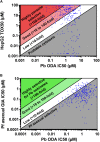Fueling Open Innovation for Malaria Transmission-Blocking Drugs: Hundreds of Molecules Targeting Early Parasite Mosquito Stages
- PMID: 31572339
- PMCID: PMC6753678
- DOI: 10.3389/fmicb.2019.02134
Fueling Open Innovation for Malaria Transmission-Blocking Drugs: Hundreds of Molecules Targeting Early Parasite Mosquito Stages
Abstract
Background: Despite recent successes at controlling malaria, progress has stalled with an estimated 219 million cases and 435,000 deaths in 2017 alone. Combined with emerging resistance to front line antimalarial therapies in Southeast Asia, there is an urgent need for new treatment options and novel approaches to halt the spread of malaria. Plasmodium, the parasite responsible for malaria propagates through mosquito transmission. This imposes an acute bottleneck on the parasite population and transmission-blocking interventions exploiting this vulnerability are recognized as vital for malaria elimination.
Methods: 13,533 small molecules with known activity against Plasmodium falciparum asexual parasites were screened for additional transmission-blocking activity in an ex vivo Plasmodium berghei ookinete development assay. Active molecules were then counterscreened in dose response against HepG2 cells to determine their activity/cytotoxicity window and selected non-toxic representative molecules were fully profiled in a range of transmission and mosquito infection assays. Furthermore, the entire dataset was compared to other published screens of the same molecules against P. falciparum gametocytes and female gametogenesis.
Results: 437 molecules inhibited P. berghei ookinete formation with an IC50 < 10 μM. of which 273 showed >10-fold parasite selectivity compared to activity against HepG2 cells. Active molecules grouped into 49 chemical clusters of three or more molecules, with 25 doublets and 94 singletons. Six molecules representing six major chemical scaffolds confirmed their transmission-blocking activity against P. falciparum male and female gametocytes and inhibited P. berghei oocyst formation in the standard membrane feeding assay at 1 μM. When screening data in the P. berghei development ookinete assay was compared to published screens of the same library in assays against P. falciparum gametocytes and female gametogenesis, it was established that each assay identified distinct, but partially overlapping subsets of transmission-blocking molecules. However, selected molecules unique to each assay show transmission-blocking activity in mosquito transmission assays.
Conclusion: The P. berghei ookinete development assay is an excellent high throughput assay for efficiently identifying antimalarial molecules targeting early mosquito stage parasite development. Currently no high throughput transmission-blocking assay is capable of identifying all transmission-blocking molecules.
Keywords: drug; malaria; ookinete; screening; transmission.
Copyright © 2019 Delves, Lafuente-Monasterio, Upton, Ruecker, Leroy, Gamo and Sinden.
Figures






References
-
- Bemis G. W., Murcko M. A. (1996). the properties of known drugs. 1. molecular frameworks. J. Med. Chem. 39 2887–2893. - PubMed
LinkOut - more resources
Full Text Sources

